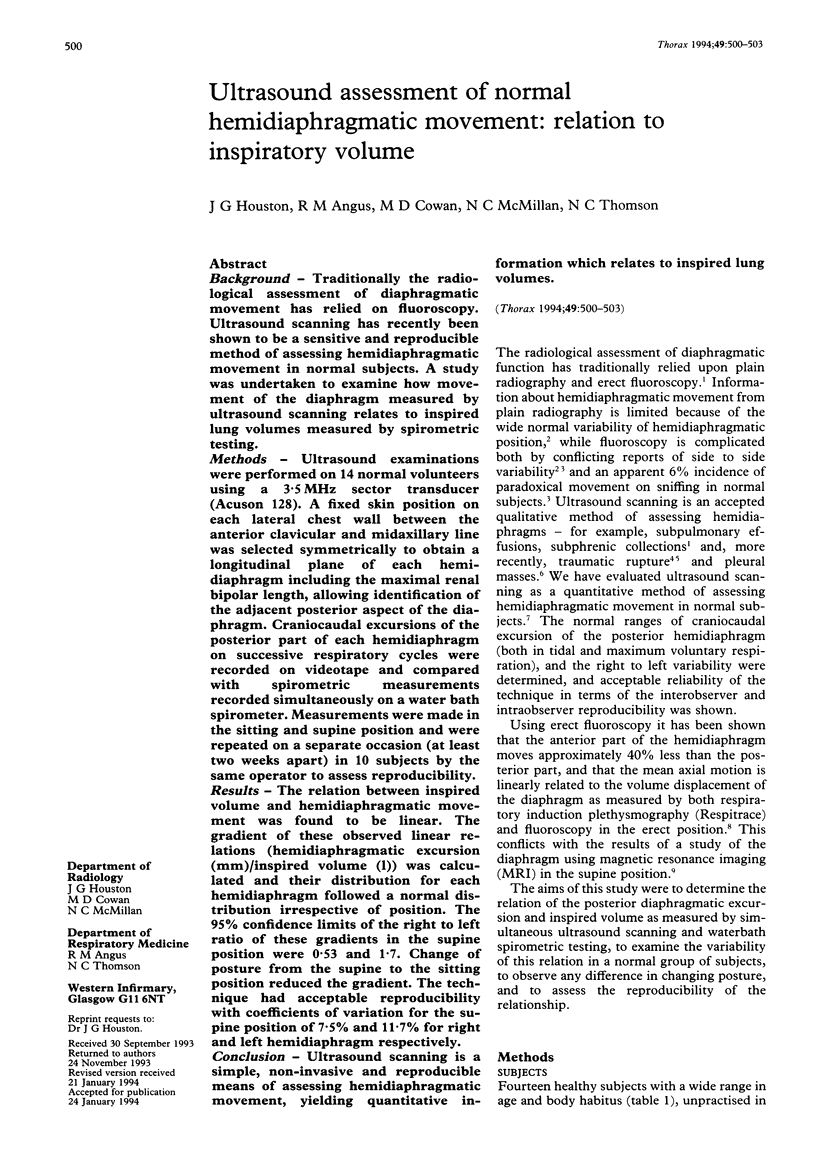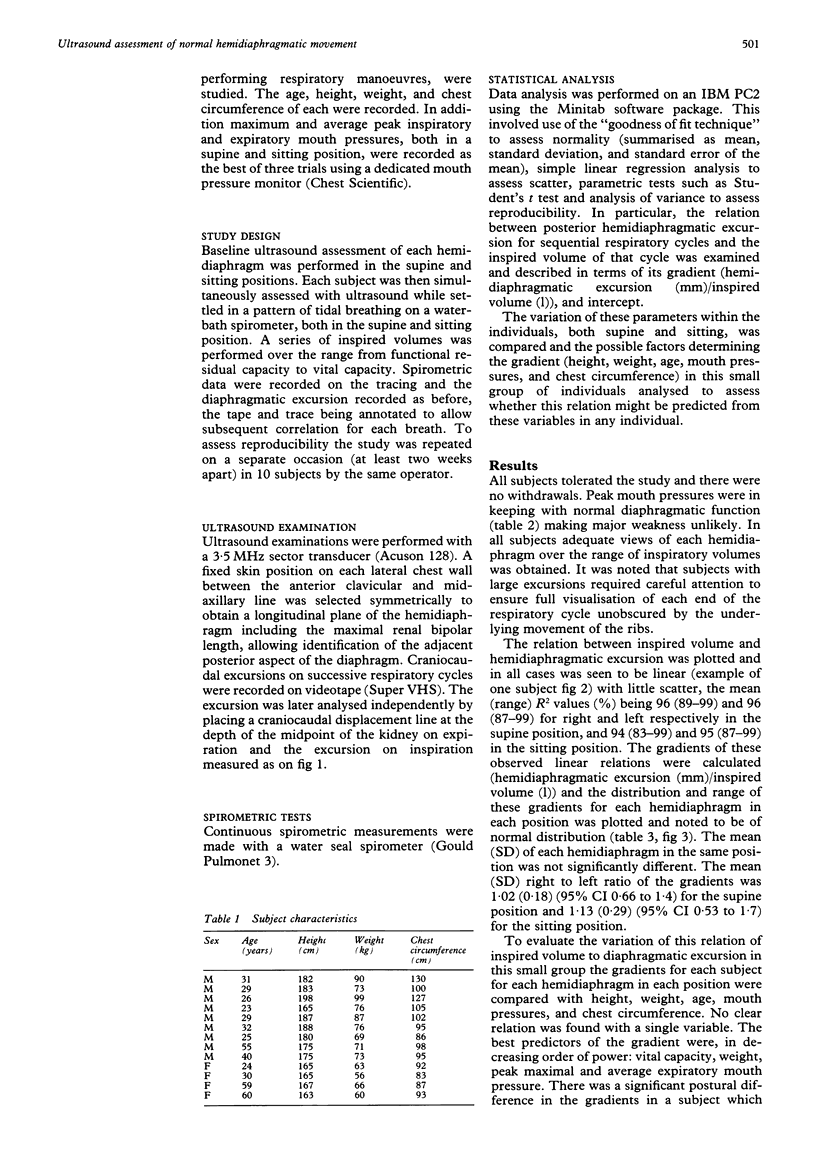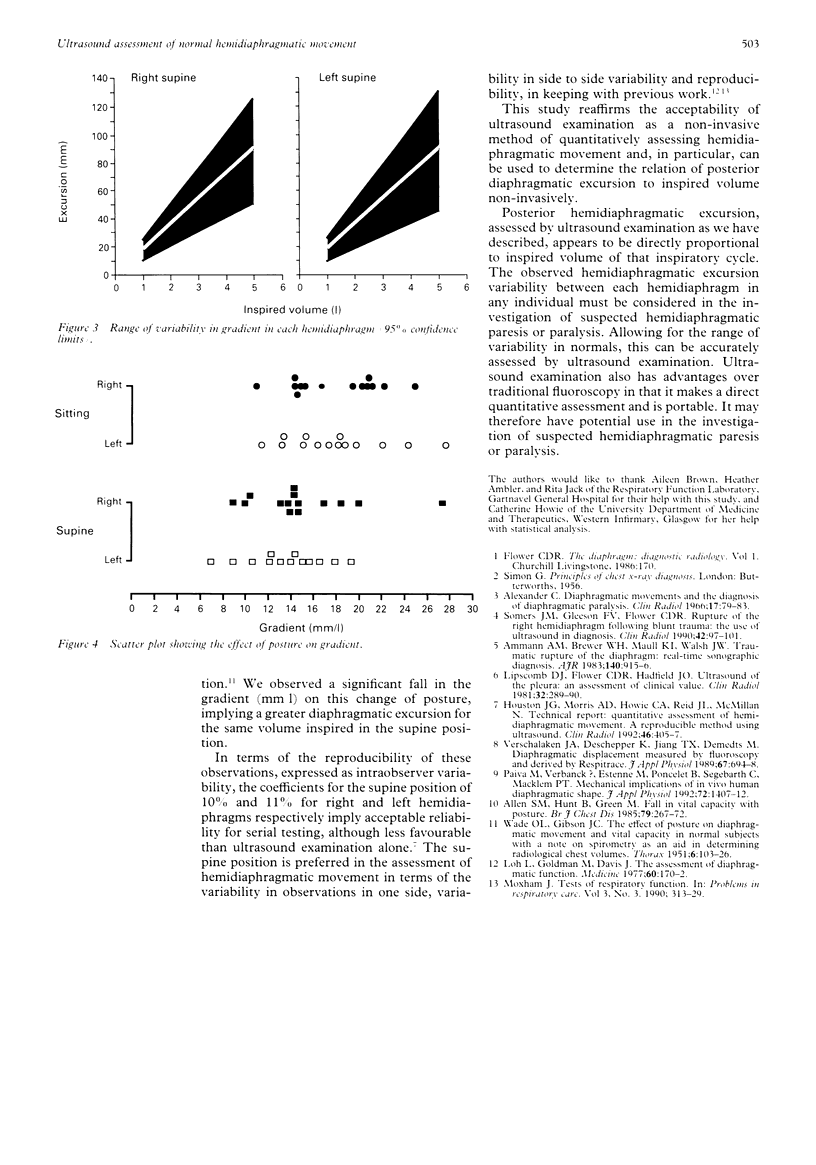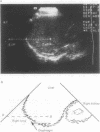Abstract
BACKGROUND--Traditionally the radiological assessment of diaphragmatic movement has relied on fluoroscopy. Ultrasound scanning has recently been shown to be a sensitive and reproducible method of assessing hemidiaphragmatic movement in normal subjects. A study was undertaken to examine how movement of the diaphragm measured by ultrasound scanning relates to inspired lung volumes measured by spirometric testing. METHODS--Ultrasound examinations were performed on 14 normal volunteers using a 3.5 MHz sector transducer (Acuson 128). A fixed skin position on each lateral chest wall between the anterior clavicular and midaxillary line was selected symmetrically to obtain a longitudinal plane of each hemidiaphragm including the maximal renal bipolar length, allowing identification of the adjacent posterior aspect of the diaphragm. Craniocaudal excursions of the posterior part of each hemidiaphragm on successive respiratory cycles were recorded on videotape and compared with spirometric measurements recorded simultaneously on a water bath spirometer. Measurements were made in the sitting and supine position and were repeated on a separate occasion (at least two weeks apart) in 10 subjects by the same operator to assess reproducibility. RESULTS--The relation between inspired volume and hemidiaphragmatic movement was found to be linear. The gradient of these observed linear relations (hemidiaphragmatic excursion (mm)/inspired volume (1)) was calculated and their distribution for each hemidiaphragm followed a normal distribution irrespective of position. The 95% confidence limits of the right to left ratio of these gradients in the supine position were 0.53 and 1.7. Change of posture from the supine to the sitting position reduced the gradient. The technique had acceptable reproducibility with coefficients of variation for the supine position of 7.5% and 11.7% for right and left hemidiaphragm respectively. CONCLUSION--Ultrasound scanning is a simple, non-invasive and reproducible means of assessing hemidiaphragmatic movement, yielding quantitative information which relates to inspired lung volumes.
Full text
PDF



Images in this article
Selected References
These references are in PubMed. This may not be the complete list of references from this article.
- Ammann A. M., Brewer W. H., Maull K. I., Walsh J. W. Traumatic rupture of the diaphragm: real-time sonographic diagnosis. AJR Am J Roentgenol. 1983 May;140(5):915–916. doi: 10.2214/ajr.140.5.915. [DOI] [PubMed] [Google Scholar]
- Ammann A. M., Brewer W. H., Maull K. I., Walsh J. W. Traumatic rupture of the diaphragm: real-time sonographic diagnosis. AJR Am J Roentgenol. 1983 May;140(5):915–916. doi: 10.2214/ajr.140.5.915. [DOI] [PubMed] [Google Scholar]
- Verschakelen J. A., Deschepper K., Jiang T. X., Demedts M. Diaphragmatic displacement measured by fluoroscopy and derived by Respitrace. J Appl Physiol (1985) 1989 Aug;67(2):694–698. doi: 10.1152/jappl.1989.67.2.694. [DOI] [PubMed] [Google Scholar]
- Verschakelen J. A., Deschepper K., Jiang T. X., Demedts M. Diaphragmatic displacement measured by fluoroscopy and derived by Respitrace. J Appl Physiol (1985) 1989 Aug;67(2):694–698. doi: 10.1152/jappl.1989.67.2.694. [DOI] [PubMed] [Google Scholar]
- WADE O. L., GILSON J. C. The effect of posture on diaphragmatic movement and vital capacity in normal subjects with a note on spirometry as an aid in determining radiological chest volumes. Thorax. 1951 Jun;6(2):103–126. doi: 10.1136/thx.6.2.103. [DOI] [PMC free article] [PubMed] [Google Scholar]
- WADE O. L., GILSON J. C. The effect of posture on diaphragmatic movement and vital capacity in normal subjects with a note on spirometry as an aid in determining radiological chest volumes. Thorax. 1951 Jun;6(2):103–126. doi: 10.1136/thx.6.2.103. [DOI] [PMC free article] [PubMed] [Google Scholar]



